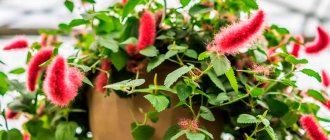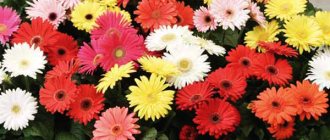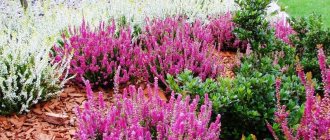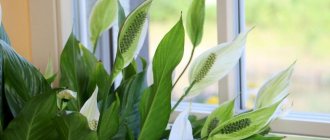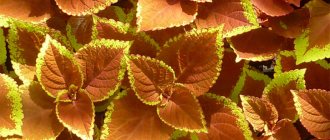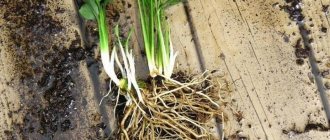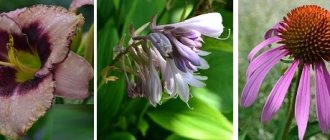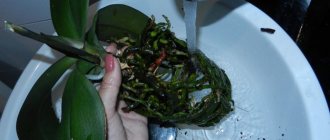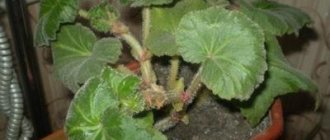'Merry Family' is an attractive plant covered in trumpet-shaped flowers and drooping leaves. It is also called Achimenes. The tropical latitude of Central America is considered its homeland.
The flower grows well indoors and pleases owners with its bright colors. But in order for Achimenes to bloom to its full potential, it needs to be looked after. A flower not only perfectly decorates the interior of the house, but also brings happiness (many experienced flower growers think so).
Features of the plant
A distinctive feature of the unpretentious “cast iron flower” is the absence of a stem. From the rhizome, half hidden by the ground, glossy elliptical leaves immediately grow.
Accustomed to living in cool, dense forests and indoor conditions, the “friendly family” does not have any special care requirements. So you will feel equally comfortable in rooms facing north, in poorly lit corridors and even in offices with artificial lighting. At the same time, it is capable of perfectly purifying the surrounding atmosphere from harmful impurities, including benzene and formaldehyde.
Description
This variety is classified as dwarf. Dahlias “cheerful guys” can have different heights - from 25 to 70 cm. Their name comes from the incredibly bright and varied colors of these flowers. Dahlias "funny guys" have a fairly strong stem. The foliage is bright green. Sometimes it can be brownish-burgundy - this is typical for those species that produce dark red flowers. This variety has one amazing feature: the lower the bush, the earlier the plant produces buds.
Dahlias “cheerful guys”, photos of which are familiar to almost every gardener, can have white, pink, lilac, burgundy, red and yellow inflorescences. They are found everywhere. They can be seen not only in flower beds or borders, but also on terraces and in flower pots. They are familiar to almost everyone, although many do not even suspect that these are the “fun guys” dahlias. The inflorescences are a basket, inside of which there are tubular flowers framed by reed petals. They can reach 8-10 centimeters in diameter.
Home care
In principle, aspidistra is very unpretentious. It does not put forward any special requirements for watering, lighting, and is not afraid of temperature changes. So even a novice gardener can cope with caring for her.
Location and lighting
Unlike most green plantings, aspidistra does not require bright lighting. On the contrary, the plant may wither due to excess sunlight. So in the summer, place a pot with a “cast iron flower” on northern window sills. But even in this case, shade the flowerpot on clear days. It’s better to place the pots on the wall away from the window. Just don’t put variegated varieties too far away, because if there is not enough light, the leaves may become monochromatic. In autumn and winter, you can move the flowerpot to the western or eastern window sills.
Temperature
The “snake pointer” does not tolerate heat well. It is advisable that in the warm season the air temperature should not be higher than +25°C. And preferably around 20 degrees. When the cold comes, you can lower the air to +15°C. Even +10 degrees will not harm the plant. In cool weather, the leaves will develop even more actively. Sudden changes in day and night temperatures are not scary for the green ward. He is also not afraid of drafts.
Watering
On summer days, the aspidistra needs to be watered approximately once a week. Just make sure that the earthen ball is not too flooded. After all, for a flower, an excess of moisture is much worse than a lack. Try to water until the substrate is two-thirds dry. In winter, when the pet is at rest, 1-2 waterings per month will be enough. Leave the water for 24 hours before watering.
Air humidity
Aspidistra does not need high air humidity. But in the spring-summer period, once a week it is advisable to spray the wide leaves or wipe them with a damp cloth, cleaning them from dust. In winter, do this no more than once or twice a month.
The soil
For a “friendly family”, a universal soil is suitable. You can take garden or garden soil. If you want to make a soil mixture yourself, take the ingredients in the following proportions:
- 40% turf land;
- 20% leaf soil;
- 20% humus;
- 20% sand.
Ready-made soil for palm trees and ficus trees is also suitable.
Feeding and fertilizers
Aspidistra should be fed with liquid complex fertilizers with sufficient nitrogen content. Follow the instructions on the package very carefully so as not to kill your pet by overdose.
Feed it once a month, starting in April and ending in October. In winter, the plant does not need fertilizer. It is better not to fertilize variegated forms at all so that they do not lose their decorative properties.
Transfer
There is no need to frequently replant the aspidistra. Unless a young flower needs to be moved to a new flowerpot every year. For adult bushes, replanting once every 2-4 years is enough. But select a new pot with a diameter 2 times larger than the previous one, so that the roots have room to grow.
The container must have drainage holes, and the bottom is covered with a drainage layer of expanded clay, crushed stone or ceramic fragments. Drainage will protect the roots from rotting if more moisture gets into the pot than the green friend needs.
In early spring, carefully remove the plant along with the clod of soil, transfer it to a new flowerpot and add fresh soil at room temperature to fill the voids. Make sure that the roots are not completely covered with soil.
If in a new place the “cast iron flower” initially stops growing, do not panic. He just needs time to adapt.
Trimming
If you notice withered, yellowed leaves, get rid of them as soon as possible so that your pet looks beautiful and does not contract a fungal disease. Trim old foliage with sharp, sterile pruning shears, making a cut at the very base of the bush.
If you notice the appearance of smooth green leaves on a variegated pet, trim them too. Otherwise, a single color will begin to dominate and the decorative effect will be lost.
Some tips for choosing seeds
Today on sale you can find combined variety mixtures with all the shades of inflorescences that so delight the eyes of the “cheerful guys”.
Dahlia seeds can be purchased at any specialty store. From one package you can immediately grow red, yellow, pink, white flowers - the whole palette. But it’s not just the shades of the inflorescences that distinguish the “cheerful guys” dahlia species. Planting and caring for them are procedures that also depend on what seed variety was purchased. The fact is that these annuals are also divided into simple or double types of flowers. It is important to pay attention to the information on the packaging. After all, the start of flowering also depends on the height of the bushes. For example, simple species grow up to 30-40 cm. Terry dahlias “funny guys” are usually a little taller, however, the number of flowers on them is smaller.
Bloom
In indoor conditions, aspidistra rarely spoils its owners with flowering. But with proper care, pink flowers may appear in summer, and sometimes even in winter, resembling stars in appearance. The plant blooms for only a day. In addition, the flowers are located right at the roots. So you may not even notice this process. In place of the flower, a fruit appears with a rather large seed inside. In order for a pear-shaped fruit to appear, the ward must be pollinated.
Aspidistra in floristry
Aspidistra is good as a complement to other cut flowers in a variety of arrangements.
The same aspidistra elatior and its striped variation are most often used as a cutting crop.
Aspidistra is a plant with an elongated-swaying active growth form . According to floristic laws, it belongs to flowers of medium importance.
Aspidistra is especially good in compositions with plants that have a rough texture, and with plants with delicate inflorescences - orchids, lisianthus, roses.
Aspidistra is a very flexible floral material: it can be used as a cuff for a bouquet, because it can easily be transformed into various forms (balls, waves, etc.).
bouquet with aspidistra
Reproduction
Most often, a new aspidistra is grown by dividing the bush. But if you wish, you can tinker with leaf cuttings and even seeds.
Dividing the bush
You will get a guaranteed result if in the spring, when replanting a plant, you cut off a part of the bush with 3-6 leaves and roots with a sharp knife. Dry the cut areas, sprinkle with charcoal, crushing it well before the procedure. Treat with root. Plant the mother flower and the cut part in separate pots. The soil must first stand indoors so that it is not cold.
While the seedlings take root, keep the room cool. It should be no more than +18-20 degrees. There is no need to over-fill them at first to avoid rotting. Don’t rush to feed either. You will do this for the first time about a month after the transplant.
Cuttings
If you want to tinker more, cut off the leaf. Make the cut closer to the base in the place of the thickened influx, but without the petiole. Take a bottle with a wide neck. Fill with water, place the stem inside, close the lid and make a plasticine plug.
Place it on the windowsill to keep the sprout warm and light. Pull it out only when it sprouts whitish roots. Plant the seedling in loose, damp soil, covering it with a cut-off plastic bottle to create a mini-greenhouse. When the pet takes root and produces leaves, you can remove the bottle.
If the bottle is not sealed tightly, the tip of the leaf may begin to rot if air gets in. Take it out of the container, rinse it, and make a new cut where the thickening occurs. Replace the water in the bottle, lower the stem and seal again. This time, try to cover it thoroughly with plasticine. To be sure, you can throw away the damaged leaf and put a fresh leaf cutting in the bottle for rooting.
Seeds
Sow aspidistra seeds in spring. Deepen several seeds at once into a container with a damp substrate by 5-10 mm. Spray the soil with a spray bottle. Cover the top with glass and transfer to a warm but dark place. You can use a transparent plastic container with a lid for germination. It's much more convenient this way. Just don't forget to make drainage holes.
Every day, remove the glass or lid from the container for a while to allow the condensation to evaporate. After waiting for the shoots to emerge, move the container closer to the light. When the sprouts become strong, carefully remove them and plant them in separate small flowerpots. But again cover with jars or plastic bottles upside down. When leaves begin to form, the shelter can be removed completely.
Feeding
If the soil has already been fertilized, then this is quite enough for the “cheerful guys”. The main thing is that the fertilizer has time to decompose so that the nutritional components in it become available to the roots. Therefore, experts recommend fertilizing the soil in late autumn.
For more luxuriant flowering, dahlias are fed three times a day:
- fifteen days after transplanting the crop into open ground with mullein infusion;
- after budding with superphosphate or potassium salt;
- in the flowering phase with organic matter.
It is very important not to overfeed the plant with nitrogen fertilizer: this will only lead to powerful leaf growth, while flowering may not occur at all.
Diseases and pests
Aspidistra is not susceptible to frequent diseases, and pests are usually indifferent to it. But sometimes troubles can happen.
Shchitovka
You can see these small creatures with the naked eye. Remove affected leaves immediately. Treat the remaining clean ones with a solution of laundry soap and water. Then give the green mass showers. Just pre-wrap the flowerpot with polyethylene so that excess moisture does not seep into the roots. If the situation is advanced, use insecticides.
Spider mite
If you notice a sticky web on the bottom of the leaves, wipe the infected areas with a cloth soaked in vodka or alcohol diluted in water. Take the flowerpot out into the yard and treat it with an insecticide. If you do this indoors, be sure to open the window for ventilation.
Root rot
The fungus attacks foliage due to increased dampness in the room and too frequent watering.
Chlorosis
It develops if watering is done with low-quality water. Fertilize the bush and water with clean water.
Infectious chlorosis
Unfortunately, there is no escape from this scourge. If the leaves turn yellow, changing color, the sick pet will have to be destroyed.
Soil requirements
To successfully grow these annual flowers, you need to take care of the quality of the soil. The soil must be fertile, neutral and not oversaturated with moisture. Stores sell ready-made compositions for dahlias “cheerful guys”. However, you can make the substrate yourself. To do this, in the fall you need to prepare fertile soil mixed with heated sand, peat or humus in equal quantities.
Before planting seeds for seedlings, this soil mixture should be calcined and then treated with a solution of potassium permanganate. This will not only disinfect it, but also protect the “jolly fellow” dahlia from many diseases. Planting seeds for seedlings is carried out in the early stages - at the end of March or beginning of April. Sowing directly into the ground is carried out after the risk of frost has completely disappeared.
Care errors
Despite its unpretentiousness, aspidistra can respond to poor conditions by losing its beautiful appearance:
- Spots on leaves. Indicates sunburn. Move the flowerpot from the south window to the north one or push it deeper into the room.
- The leaves are turning yellow. A similar phenomenon may remind you of the advanced age of your green friend. But it happens that due to excess moisture the roots begin to rot. In this case, increase the intervals between waterings. Treat the foliage with fungicides, and pour a weak solution of potassium permanganate into the soil.
- Drying ends. Occurs from lack of moisture. Water as needed, without allowing the earthen clod to dry out.
- The leaves are turning pale. From lack of light. Move the flowerpot closer to the window.
- Slowing in growth. May occur due to lack of nitrogen. Feed the soil.
Decorate the area with bright flowers
In July, dahlias “Jolly Fellows” begin flowering, which continues until frost.
Knowing the height of the bush, you can plan plantings in flower beds, to decorate garden paths or bright spots on the lawn.
This is done over the 4th pair of leaves. It is also necessary to promptly remove faded inflorescences. If you plan to collect your seeds for next season, leave a few on the bush.
As soon as flowering stops, they will ripen. In cool weather, remove the inflorescences from the bush and place in a warm and ventilated place. But you definitely need to let the seeds ripen on the bush, so that next year you won’t be left without your favorite flowers.
“Jolly fellows” have difficulty forming good tubers for planting. It is important to carefully observe the timing of sowing and planting so that the tuber can form within the season. They are dug up after the first frost on the ground. Now we have to properly preserve the tubers of the “cheerful” dahlia until the new season. Some gardeners, after drying, coat them with clay to retain moisture, then place them in cardboard boxes and lower them into the basement. Be sure to sign the shades of flowers in order to properly plan planting next year.
Tubers that have survived the winter are planted in open ground in May.
Unpretentious dahlias “Jolly Guys” will help you create beautiful elegant flower beds on your site without much time, effort and money. Bright and lush flowering will make the area more elegant and cozy.
This indoor flower belongs to the Gesneriaceae family and is a relative of such famous plants as Saintpaulia (violets) and gloxinia. Achimenes come in both erect (this form is also often called “bush”) and hanging. The leaves of these plants are usually slightly pubescent, and are somewhat reminiscent of nettles in shape and feel. It is for their similarities that these plants are sometimes compared. The second well-known name is “friendly family”. It comes from the propagation method of achimenes (rhizomes), which, if not planted, will sprout next year in a friendly group. Achimenes are winning more and more hearts of passionate gardeners, and this is no coincidence - the flowering bushes of Achimenes are simply wonderful! Admire how the Achimenes bloom in my collection:
It can rightfully be said that these flowers combine all the best characteristics of many popular indoor plants. Let's take a closer look at why they are so good!
Medicinal properties
Eastern medicine widely uses the leaves as a wound healing agent. It is claimed that they are able to stop bleeding and disinfect the wound.
Dentists advise strengthening your gums by chewing fresh leaves. And use them to prevent periodontitis.
A decoction of aspidistra leaves is credited with the ability to remove kidney stones and also cause the flow of urine in the body. It is suggested to be used to stop cramps, diarrhea and muscle pain.
But it is better not to start such treatment without a doctor’s recommendation.
Kinds
The number of varieties of this plant has exceeded a hundred. True, significantly fewer varieties are grown at home. Here are the most popular ones:
- High-elatior. Arrived from Japan. It is most often found among amateur gardeners. It is distinguished by large lanceolate leaves. They look like lily of the valley leaves, only their sizes are significantly larger than spring bells. Flowers of crimson or yellow-brown shades.
- Starry. The shape of the stigma of the guest from China, as you may have guessed, resembles a star.
- Large-flowered. Distributed in Vietnam. It blooms with large dirty crimson flowers.
- Milky Way (Milky Way). It is distinguished by white spots, similar to drops of milk or stars in the sky, scattered on dark green leaves. Does not lose its decorative effect even after cutting. Looks elegant in a floral composition.
- Variegata. It surprises with shiny, juicy leaf blades with cream stripes of different widths. In areas gravitating to the south, this species can be safely planted in the partial shade of the garden.
- Snow Cap. The dark green leaves at the base gradually lighten and become almost whitish towards the tips.
As you can see, the choice of aspidistra is quite wide. And if you consider that the leaves perfectly absorb fumes and odors, then in apartments whose windows overlook busy highways, you simply cannot do without such a plant.
Secrets of growing from seeds
Many gardeners like “fun guys” dahlias. Experienced gardeners call both planting and caring for these flowers trouble-free procedures. Growing this dwarf variety causes them virtually no difficulties, while beginners will still need certain knowledge of agricultural technology.
At the end of the growing season, you need to collect seeds from the bushes growing on the site, which will be planted in the next season. After the dahlias have finished flowering, you need to leave the most powerful bushes standing, wait until all the inflorescences have completely dried, and then separate the seeds from the petals. It is better to put the future planting material in a dry paper bag and store it at room temperature, hidden in a dry, dark place.
